Ultimate Guide to Auditing Your Email Campaign
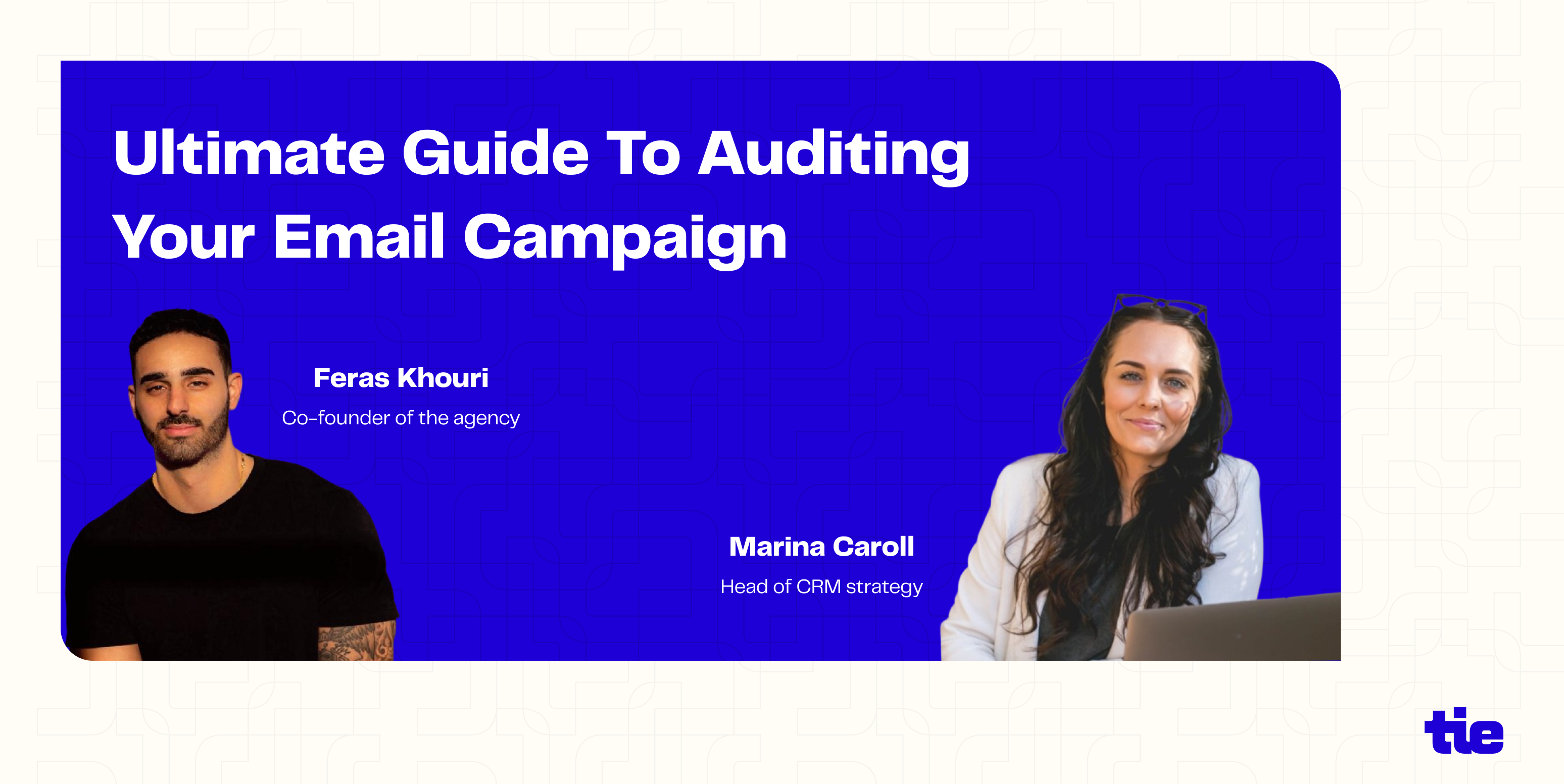
With expert insights from Marina Carroll and Feras Khouri
Most email programs are missing out on 30-40% of potential revenue by not focusing on the right details.
While deliverability and clicks might look stable, your email deliverability performance falls across a few aspects:
- Core flows stop driving incremental revenue
- Fewer users click or convert with each send
- Klaviyo attribution stays stuck under 20–30%
The most common mistake that brands make is obsessing over advanced segmentation or hyper-personalized copy before fixing the basics. They skip core flow logic, don’t test systematically, and don’t audit underperforming emails in the first place.
To break down what actually works in 2025, we spoke to two retention marketing experts at New Standard, a boutique agency trusted by 8- and 9-figure brands like BYLT and Caraway to scale retention:
- Feras Khouri, co-founder of the agency
- Marina Carroll, head of CRM strategy
This guide walks through their exact process when auditing email campaigns—what to check, what to fix, what to stop doing—and how to rebuild your email performance with clearer metrics, cleaner flows, and smarter tests.
1. Fix deliverability
Most retention marketers panic when open rates drop or spam complaints rise; they pull back sends. But that’s not how deliverability works.
Before you even think about segmentation or volume, make sure the email deliverability basics are in place. This includes proper domain authentication (SPF, DKIM, DMARC), a warmed-up sending domain, and maintaining a clean list.
If these basics are covered, and your emails still aren’t landing in inboxes, the issue is almost always list quality, audience targeting, or broken flows.
“We send over 60 campaigns a month. If your segmentation and filters are right, you can scale sends without hurting deliverability,” says Caroll.
Segment by clicks and not opens
Apple Privacy Protection has made open rates unreliable. If you're still using “opened in the last 30 days” as your main filter, you're making decisions based on misleading engagement data.
“We’re focused on click-based segmentation. Opens mean nothing now, especially with Apple privacy. If they haven’t clicked, they’re not engaged.”
- Marina Carroll

Instead, use clicks as your primary indicator of engagement:
- Filter campaign sends to “clicked in last 30/60 days.”
- Use separate segments for “never clicked” audiences and suppress or re-engage them slowly.
“Tighten your segments, send to people who want it, and pulse larger sends during sales—that’s how you rebuild rep.”
- Feras Khouri
Suppress bounced and risky profiles automatically
Every Klaviyo account should have a dynamic suppression segment that filters out contacts likely to damage deliverability. Caroll shares why this is important:
“They’re just not around anymore—you’re going to keep triggering spam if you keep emailing them.”
At a minimum, exclude hard bounces, soft bounces, and recipients who marked as spam.
“We have a rule—hard bounce once, out. Soft bounce three times, out. They go into suppression automatically. And that's put in on every send per campaign that we do.”
Monitor weekly KPIs against historical baselines
Auditing deliverability once isn’t enough. Instead, you need a recurring QA loop. Build a weekly reporting view that tracks:
- Click rate (primary indicator of inboxing).
- Unsub rate (track spikes per send).
- Gmail’s “one-click unsub” activity (new requirement).
“We do week-over-week reviews with every client. If spam rates or unsubscribes are drifting up, we catch it before it tanks performance.”
- Marina Caroll
Run strategic exclusions and phased warmups
Deliverability is not just about who you send to, but when and how you bring them back in.
- Don’t default to full-list campaigns. Instead, start small and scale intentionally.
- If you’re warming up a new segment, do it in phases:
- Start by emailing users who clicked within the last 30 days.
- Next, include 31-60 day clickers to expand reach without sacrificing engagement.
- Gradually reintroduce older, previously active profiles.
- Test creative and CTA before scaling to colder audiences
“Start by sending to engaged segments with low bounce and spam risk, then gradually open it up over time.”
- Feras Khouri
2. Start with the core: 5 flows that drive 75% of retention revenue
Before considering segmentation or personalization, you need to get your foundation right. Marina Carroll calls these the "core five"—flows that should be active, connected, and generating repeatable revenue.
"There are five core flows that every brand should have. It's your welcome series, your abandoned cart, your abandoned checkout, your abandoned browse, and then some sort of post-purchase."
These flows do the heavy lifting. If even one is missing or misfiring, you're leaking revenue daily.
Carroll's team looks for a specific outcome: "Do these drive 75% of your revenue for attribution?"
These flows are so critical that when Carroll audits a failing email program, she starts here.
"First thing to look at, I always go into flows and check the core... taking a look at the flows, making sure that they have the proper filters on it, that they have the core five flows that [are] in there running properly."
She also checks the campaign-to-flow revenue split. If your flows account for only 20-30% of total revenue and campaigns are bringing in the rest, you're likely under-automated.
"The split between attributed revenue for the email channel [should be] 50/50 between campaign and [flows]. So if I go in and I see that your flows are only driving 20%, your campaigns are 80%, that means you're not doing enough flow work."
Here are some specific best practices that Carroll shares for each of the flows:
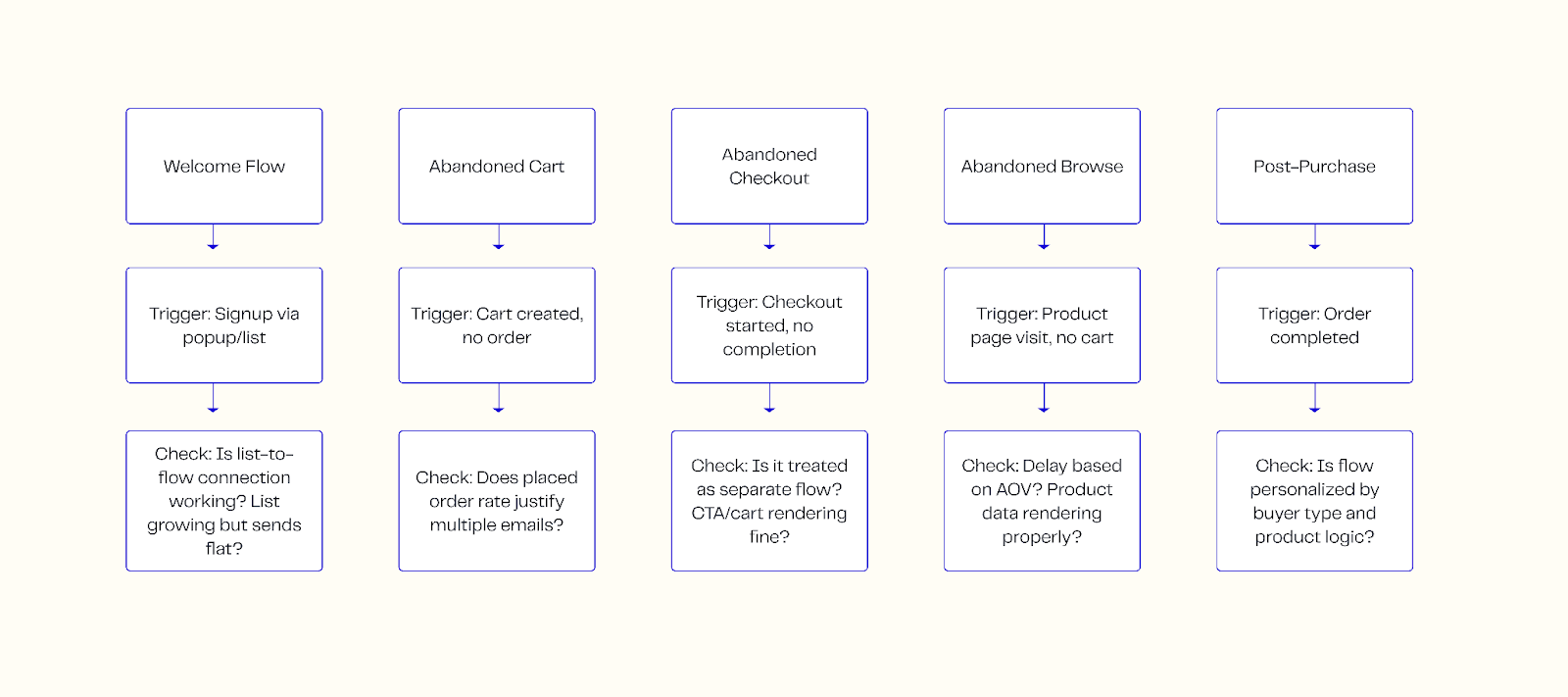
Welcome series
Trigger: New subscriber signup
Key checks:
- Confirm your popup connects to the right list and that the list triggers the welcome flow properly.
"A lot of people have a list, and it's like, okay, it's triggered off this list, but then they'll start a new popup, and the popup won't go into the list. So, they're just shooting people into Klaviyo, but they're not triggering the [welcome flow]."
- Check if list growth matches the number of welcome emails being delivered.. If your list is growing but welcome sends are flat, something's broken.
Abandoned cart flow
Trigger: Cart created, no purchase
Key checks:
- Test sequence length using placed order rates. Placed order rate measures as the number of people who place an order divided by the total recipients, helping you understand the effectiveness of your email campaign.
So, for instance, if you add a fourth email reminder and it has a high placed order rate, it’s worth keeping.
"I always check the placed order rate. So if the placed order rate is still carrying, I add another email and test it... If it's anywhere around like a 0.2, 0.3, 0.4, I'd say that's probably not driving necessary revenue."
- Hold off on discounts until the third email reminder. First few cart reminders often convert without a discount.
"I would personally not introduce a discount until email three. You have a good chunk of people that are just converting off of that email number one and two reminder."
- Always resurface the abandoned product in the email content to remind shoppers what they left behind.
"Resurfacing the product that the person abandoned... has always tested out as more revenue driving than not."

Abandoned checkout flow
Trigger: Checkout started, no purchase completion
Key checks:
- Treat this as a distinct flow from cart abandonment. Many brands mistakenly run just one email here.
“Do you have an abandoned checkout? Do you have two abandoned checkouts? Are they working?”
- Monitor the placed order rate to decide how many emails to send. Keep adding as long as conversion holds above the benchmark.
“A lot of people… have one email in an abandonment flow, and it’s like, the email [is] massively performing.”
- Validate that all dynamic elements (cart contents, CTA) render correctly.
Abandoned browse flow
Trigger: Product page visited, no cart activity
Key checks:
- Adjust the delay based on AOV:
- Low-AOV, fast-moving products: trigger within 30–45 minutes
- Higher-priced, considered purchases: delay up to 4 hours
"Faster moving cheaper product companies that have lower AOV... 45 minutes. Products that are $700 plus that you need more time to think on... 4 hours"
- Confirm that product data renders correctly in the email, since reminding the shopper what they showed interest in is critical.
Post-purchase flow
Trigger: Order completed
Key checks:
- Personalize based on customer lifecycle:
- First-time buyers: “Welcome to the brand” tone
- Repeat buyers: focus on reordering or high-value bundles
"If you just bought for the first time and then we're trying to sell you a second time, in a post-purchase flow, we're talking to you as if you're a new recent customer versus just like you're a customer."
- Recommend the next-best product based on what they just bought, not based on assumptions.
"If your top category is T-shirts and then the next best thing that's usually always purchased second based on data is pants... we show people that bought a t-shirt pants next."
3. Track and optimize by RPE, not vanity metrics
Click rates and open rates are easy to track, but they don’t tell you what matters.
“People ask about open rate and click rate, and I'm like, but do you know what actually drove revenue? That's the actual important thing.”
- Feras Khouri
If you’re serious about improving email performance, there’s only one metric that keeps you focused— revenue per email (RPE).
Revenue per email gives you a direct view into how much revenue each email sent drives. It ties performance to outcome and not attention.
The formula to calculate it is:
RPE = Total Revenue Attributed / Total Emails Delivered
“Which email actually makes you money? That’s what I want to know. Not just which one gets more clicks.”
- Feras Khouri
How to use RPE properly
Applying RPE effectively requires a few key rules:
1. Set a baseline by your flows: Different flows have different expectations. Carroll typically benchmarks around $1.00 RPE. From there, her team tests variants to improve flow-wide lift.
“We'll go in and say like, okay, your benchmark RPE for this flow is usually around a dollar. Let’s build from there.”
- Marina Carroll
2. Ignore inflated small sends: A segment of 2,000 might show great RPE, but if you’re usually sending to 4K+ recipients, it’s not scalable. Only count sends over the average volume when making decisions.
“If your average send size is 400,000 and then you send a campaign to 2,000 people that generates a $3 RPE, you’re going to look at that and say, 'oh wow, we should do that again,' but it's not repeatable.”
- Marina Caroll
3. Don’t rely on RPE alone: RPE tells you which emails drive revenue. Revenue per click tells you which messages drive revenue after engagement. If one variant gets more clicks but lower revenue per click, you’re optimizing for attention and not conversion.
“RPE is pretty much our north star with that analysis. But we also look at a collected year-over-year for what we call level one metrics.”
- Marina Caroll
What a strong RPE audit looks like
When you’re reviewing flows or campaigns, an audit tailored to RPE includes:
- Evaluating RPE based on individual flow campaigns, not just the average of all flows.
- Compare against a baseline or previous period.
- Get visibility into revenue per click to assess creative impact.
- Exclude any data from small or edge-case segments.
4. Run a 30-minute email audit
Before you run A/B tests or segment your list into micro-audiences, start with an audit. A 30-minute audit can surface the biggest problems hiding in plain sight, and most of them have nothing to do with subject lines or send times.
“We go down the funnel [and check]: was it delivered? Did it get into the inbox? Did it get opened? Did they click it? Did they purchase?”
- Feras Khouri
Here’s what to look into:
Are all 5 core flows live?
Go into Klaviyo and confirm that each one (welcome, cart, checkout, browse, post-purchase) is active, correctly triggered, and has sent emails in the past 7 days. If even one isn’t working, you're missing revenue every single day.
Do flows capture your actual list?
Check the connection between your popup and your welcome flow. This breaks more often than you think.
“A lot of people have a list, and it's like, okay, it's triggered off this list, but then they'll start a new popup, and the popup won't go into the list. So, they're just shooting people into Klaviyo, but they're not triggering the [welcome flow].”
- Marina Caroll
Audit the segment that each flow is triggered from.
For instance, If your list size is growing but welcome sends are flat, you're routing new contacts into the wrong segment or missing the trigger altogether.
Are filters too aggressive?
A common mistake is over-suppressing contacts. While excluding anyone who’s received an email in the last 90 days might sound safe, it’s likely killing volume.
“Are you suppressing people that have already purchased? Are you suppressing people that have clicked but not purchased?”
- Feras Khouri
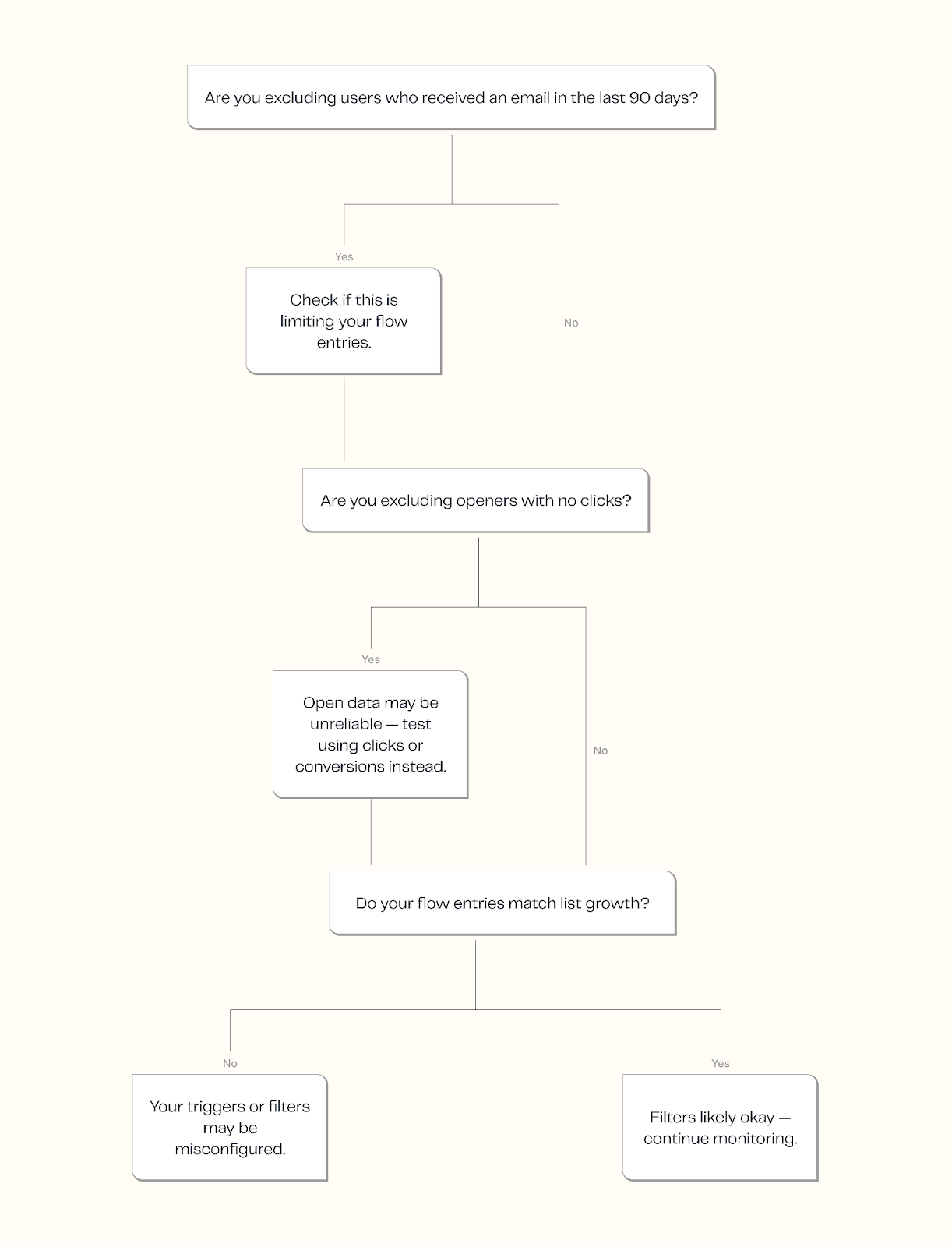
Start by checking:
- The number of people entering each flow vs. your list growth rate
- Whether your filters (e.g., “has not received email in 60–90 days”) are too restrictive.
- Whether you’re excluding based on non-clicked opens, which are now unreliable post-Apple Privacy.
“There are clients who will suppress people who’ve opened but not clicked… since with Apple Privacy, open rates aren’t reliable anymore.”
- Marina Caroll.
Are dynamic blocks failing?
Empty product blocks, broken personalization, or layout issues create dead ends that quietly tank performance. To fix this:
- Preview your emails using sample profiles.
- Check how blocks render across devices and inboxes.
- Confirm that logic like “show top 3 items from last session” is pulling real data.
“Check if dynamic product blocks are populating correctly… sometimes you have personalization that doesn’t render, and it breaks the whole layout.”
- Marina Caroll
5. Stop over-personalizing
Most DTC brands assume personalization will lift performance. In reality, it often drags it down.
Over-segmenting leads to bloated workflows, smaller sends, and negligible lift. Unless your logic is backed by real behavior or SKU data, the extra effort rarely pays off.
“At what point are you doing more work for the same results? You don’t need 22 versions of an email to get 90% of the revenue.”
- Feras Khouri.
Both Carroll and Khouri have seen this play out repeatedly: brands build complex journeys based on demographics or attributes, but ignore the one thing that matters—does it drive revenue?
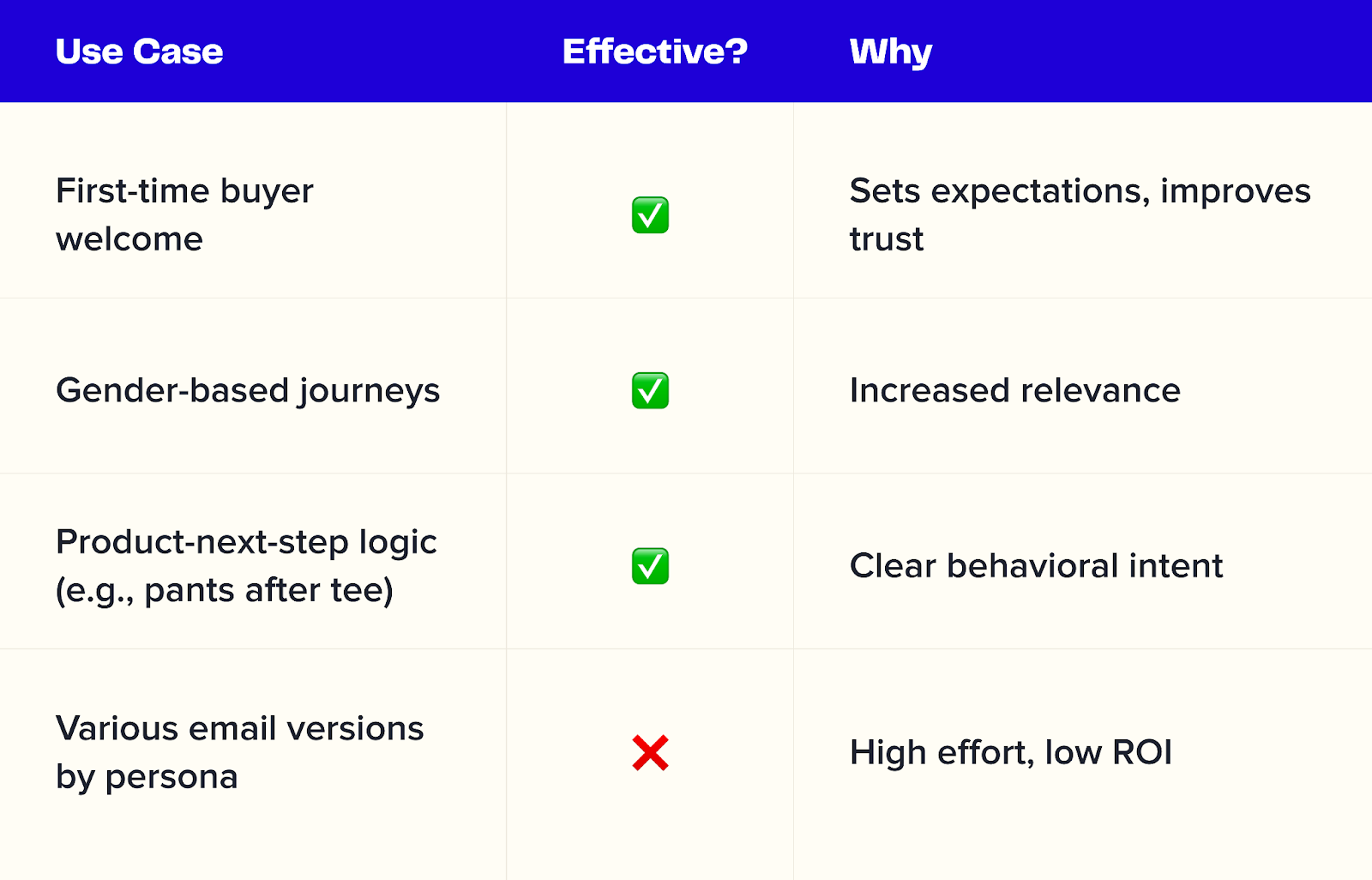
Here’s when it works:
- First-time buyers: A personalized tone in the post-purchase flow (like welcoming them, explaining what to expect, and offering the next logical product) can improve repurchase rate.
“If someone just bought for the first time and you personalize that email to welcome them, explain next steps... you're more likely to see a repeat.”
- Marina Caroll
- Clear next-step logic: If you know that customers who buy t-shirts often buy pants next, push pants. Don’t overthink it.
- High-AOV products: In categories like cookware or supplements, journey-based education and split logic (e.g., kit buyers vs. single-product buyers) can help move the second purchase.
“If you're not confident that your flows are working, then adding personalization won't help. You should test the base first.”
- Marina Caroll
What to do instead
Rather than layering on static personalization (like name, gender, or location), both Carroll and Khouri recommend focusing on live behavior and product journey logic:
- Clicks over traits: Use click data, product views, and cart behavior to drive segmentation. These are clean, real-time signals.
- Segment by journey stage: Are they a new buyer? A one-time customer? A subscriber who dropped off? Let their actions define what they see next.
“Use click data, product views... not gender or location if it doesn't change outcome.”
- Feras Khouri
- Product-based logic that scales: Set up rules like:
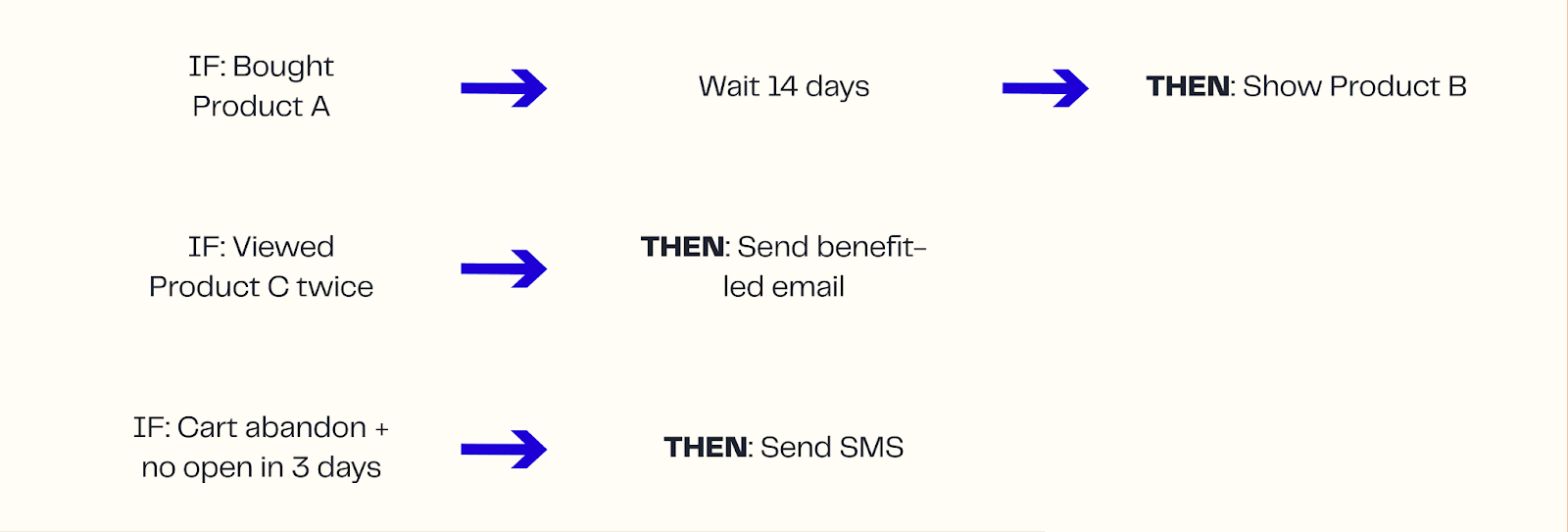
“If people purchase product A, are they likely to purchase product B? After how many days?”
- Feras Khouri
- Only narrow segmentation if Revenue Per Email (RPE) proves it: If a split audience doesn’t outperform your broader list, it’s probably not worth maintaining.
“You probably won’t see any incremental lift for the amount of work... Do a couple tests.”
- Feras Khouri
6. Prioritize A/B tests that drive results
Most brands spend time on surface-level changes (like subject lines, button colors, and font styles) that barely register in revenue.
The goal is to focus on what moves revenue, starting with the highest-impact variables and testing them in parts of your program that get consistent traffic and deliver reliable data.
“So I think first and foremost, you need to be very hyper aware of why you're testing it, and then where are you going to use that in the future?”
- Marina Caroll
Why testing flows is a priority
Flows (like abandoned cart, checkout, and welcome) run 24/7. They’re triggered by intent, not calendar. That gives you a clean, consistent environment to isolate what’s truly working.
Campaigns, on the other hand, vary wildly based on timing, promotions, and external noise. They're useful for messaging and creative tests, but it’s not what you start optimizing.
“We do a lot of tests in flows. We like those the most over campaigns, and that's just because it's a constant flow of people.”
- Feras Khouri
Variables to test first (and why it matters)
Carroll and Khouri both focus on variables with the highest potential to lift Revenue Per Email (RPE), conversion rate, and average order value (AOV).
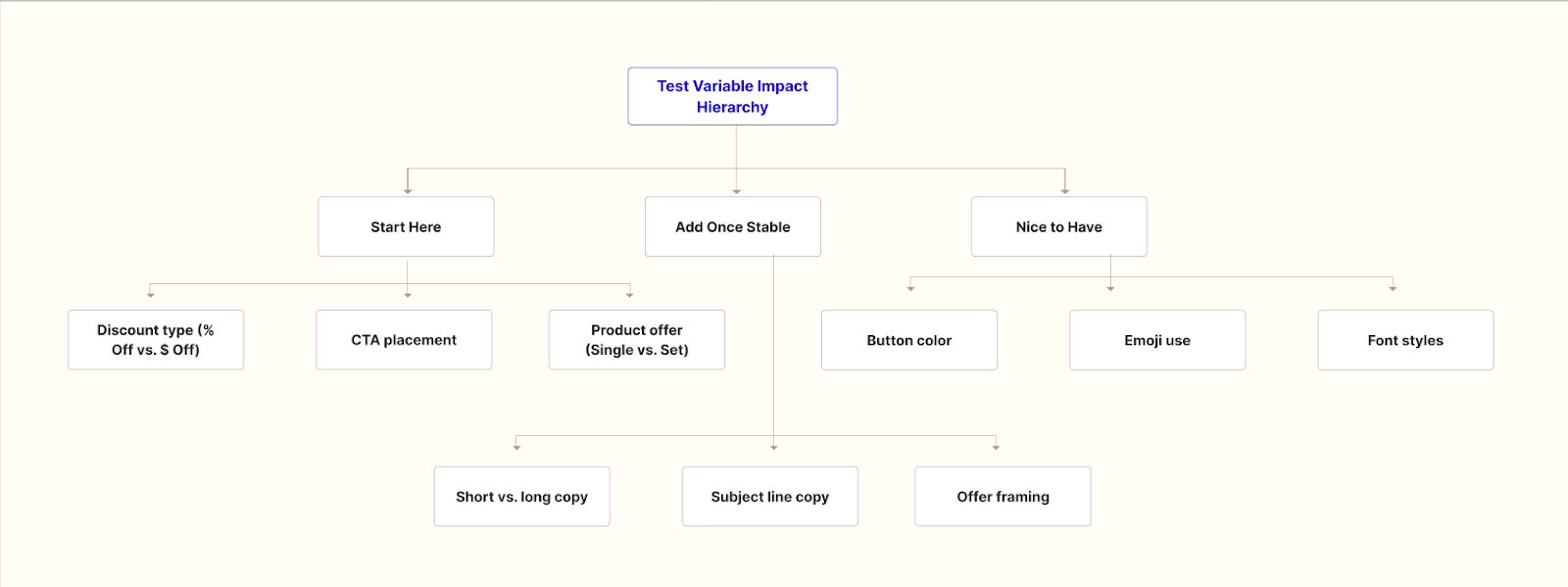
Here’s what consistently moves numbers:
- % Off vs. $ Off: Which discount structure converts better for your AOV? $10 off often feels more tangible than 15% but only testing will confirm.
“Should discounts be percentage or dollar off? What does resonate with people psychology-wise, to see if they're clicking more on something that they see the dollar off version versus a percentage?”
- Marina Caroll
- Above-the-fold CTAs: Don’t bury the CTA. Most users don’t scroll. Test placement, copy, and button strength early.
“It’s kind of like websites—most people don’t scroll past 30%. What are you talking about at the top of the email? Is your offer clear and concise?”
- Feras Khouri
- Single product vs. set merchandising: Selling a $75 pan vs. a $300 cookware set triggers different behaviors. Test each in post-purchase or cart flows to see what drives entry vs. AOV.
“If I'm selling you a pan, it's only 75 bucks to get in the door. But if I'm selling you a set, it's 300, but you're saving. Which one resonates with first-time purchasers better? I don't know. Let's test it.”
- Marina Caroll
- Short vs. long copy: Some products convert with one strong image and a line of copy. Others need more education. Testing helps you avoid overwriting or underselling.
“Each brand we will test short versus long… some brands it'll prove out that people only want the hero only. They actually couldn’t care less what you put below the scroll fold.”
While details like subject lines, emoji usage, or button colors can have an impact, it’s only when tested at volume and with statistically significant splits.
“Low-lift tests are fine to run in the background. Just don’t lead with them if your flows are underperforming.”
Use Tie to audit, fix, and scale your email campaign!
With an underperforming email program, it’s rarely about one big mistake. Poor performance is usually due to a series of small gaps across deliverability, targeting, messaging, or segmentation that compound over time.
This audit framework gives you a clear and holistic path to spot those gaps and fix them across all aspects of your email strategy.
But what if you have no visibility into who your audience is? That’s where Tie comes in.
Tie, an identity resolution platform, fills the gaps that your email marketing platform can’t. It identifies anonymous visitors, enriches customer profiles with verified attributes, and automatically feeds them into your email and ad channels. It also allows you to:
- Capture high-intent traffic that would otherwise stay anonymous.
- Boost deliverability and click rates with higher-quality, verified email lists.
- Scale flows and campaigns by feeding more enriched users into your existing ESP.
Want to see how it works? Book a demo now!






